DR. B PRABHAKAR, AQUA SPECIALIST
Aquarium Ornamental pet Fish Disease : Symptoms & Treatments
In the global scene, tropical aquarium fish keeping is considered as the second largest hobby next only to photography. The practice of maintaining fish for ornamental purpose is known from Tang dynasty (680 to 908, A.D). Ornamental fish keeping was initiated as a small time hobby using gold fish during the 18th century. In 20th century; aquarium keeping and rearing of ornamental fish got worldwide recognition. At present this technique has developed in to an extensive and global component of international trade worth millions of dollars.The ‘developing countries’ account for about 63.0% of the export value. According to Dr. Kevan Main of Harbor Branch Oceanographic Institution, nearly 90.0% of fresh water ornamental fish are captive bred. The same author has indicated that about 25 of 8,000 marine ornamental species only are easily raised. Hence, much scope exists for breeding and domesticating many high-value marine ornamental fish. In India, a variety of fresh water and marine ornamental fishes are available. About 600 of species have been identified as potential fishes with ornamental value. The trade in India fetches about Rs. 50 crores /year. However, the success of ornamental fish culture or breeding depends on the health status of the candidate species. Several diseases of economic importance are recorded and the common diseases, symptoms and methods of inspection together with treatment protocols are summarized in this article.
Causative factors for fish diseases:
The causative factors of fish diseases can be grouped under six broad categories:
- Internal to the individual – genetic diseases 2. Environment associated diseases (such as critical intensities of light/temperature/pH/ dissolved gases) 3. Physical injuries (ex: handling/transporting) 4. Nutritional diseases (ex: deficiency syndromes) 5. Co-existing organisms (biological entities) 6. A combination of a few or all factors indicated above. General methods to detect the health of fish in field conditions:
- Visual examination is one of the quickest and least costly and requires a well-trained eye. But it need not be highly reliable.
Some of the quick indicators are given below:
External:
Reflexes: In healthy fishes, reflexes will be quick such as: Escape reflex, Eye reflex and Tail reflex. The other types of symptoms may be: Sluggish behaviour Twirling, spiral or erratic movements Faded or darkened pigmentation Exophthalmus or ‘pop eye’ condition Hemorrhages Erosion of jaw or mouth Gill parasites, gill erosions, white nodules Tailor fin rot Distended abdomen (Dropsy) Protruded anus (vent) Blood oozing Ulcers/boils (furuncles) External parasites Cotton wool like growth Internal: Gas . filled hollows Ascitic fluid in the abdominal cavity Hemorrhages in the muscle wall/air bladder/ internal organs Liquid in the air bladder White nodules in internal organs Swelling of organs (Kidneys, liver etc.,) 2. Microscopic and Histologic examination: Impression smear or wet mount preparation can be examined using a light microscope. This is a rapid and inexpensive diagnostic tool. This method is good for observing motile bacteria and protozoa. More specific information can also be obtained from histological method when special stains are applied to the tissue sections. But it is slow and expensive. It also requires a trained technician, and some times fails to yield a definitive diagnosis. 3. Bacterial isolation: A sample is taken and either streaked on agar – based medium or introduced into a liquid broth containing a mixture of specially designed ingredients. Some media are also designed to allow the selective growth of certain bacteria from a potential mixture of pathogenic and non-pathogenic bacteria. General morphologic classification of the bacteria can be made based on the colony size, shape, color and smell. For more exact identification, biochemical characterization is often used. In this, a single purified colony is assayed for its ability to metabolize a variety of different minerals, chemicals and food sources. This is a very specific diagnostic method. However, it requires days or even weeks obtaining the results, and not all bacteria will grow on defined medium. 4. Tissue culture: As viruses cannot grow or multiply unless they are within living cells, cell cultures allow the diagnostician to grow many types of viruses in the laboratory. A sample is homogenized and added to the cells in the tissue culture flask. If virus is present in the sample, it causes the Cytopathic Effect (CPE). However, cell cultures have been developed only for some fint’ish, but not for shellfish. Rapid diagnostic tests for detecting fish pathogens: In order to prevent outbreaks, minimize the presence of pathogens and to reduce the use of antimicrobial compounds, rapid detection of pathogen is essential. They are further advantageous since the tests are: a. speedy, sensitive and accurate, b. presumptive and/or confirmatory, c. be micro-modified for inexpensive handling of large number of individuals and small volume samples, d. require non-destructive samples, e. yield qualitative and quantitative results. The results obtained from such tests can be correlated with the other clinical symptoms of the fish. Some of the important rapid diagnostic tests are given below: 1, Immuno-diagnostic assays such as Monoclonal & Polyclonal antibody assays. 2. Direct fluorescent antibody test (d-fat) 3. Enzyme immuno assays (EIAs) or ELISA 4. Dot immunobinding assay 5. Western Blotting technique 6. The Latex agglutination assay 7. DNA – based diagnostic tests 8. Polymerase Chain Reaction (PCR) tests. Common diseases and their management Viral diseases: Common disease: Lymphocystis Symptoms: Nodular white swellings (cauliflower) on fins or body. Lymphocystis is caused by virus and hence affects the cells of the fish. It usually manifests itself as abnormally large white lumps (cauliflower) on the fins or other parts of the body. This is a rare disease. Treatment: it is better to remove and destroy the infected fish as soon as possible. The other treatment is to simply separate the infected fish for several months. Bacterial diseases and treatment: 1. Fin and Tail Rot: Symptoms: Disintegrating fins that may be reduced to stumps, exposed fin rays, blood on edges of fins, reddened areas at base of fins, skin ulcers with grey or red margins, cloudy eyes. Possible predisposing factors: Poor water quality/ aquarium conditions and injury to the fin and tail. The affected area slowly breaks down. Treatment: It is advisable to treat the water or fish with antibiotics @ 20 – 30 mg per litre. For mixing with feed, 1.0% of antibiotic can be used and fed to the fish. Antibiotics such as chloromycetin (chloramphenicol) or tetracycline will be effective in controlling fin and tail rot conditons. 2. Scale Protrusion: Symptoms: Protruding scales without body bloat. Scale protrusion is essentially a bacterial infection of the scales and/or body. Treatment: An effective treatment is to add an antibiotic to the food. With flake food, use about 1 % of antibiotic such as chloremphenicol or tetracycline. In the water, add about 10 mg per litre of the required antibiotic. 3. Dropsy Symptoms: Bloating of the body, protruding scales. Causes: Dropsy is caused by bacterial infection of the peritoneal area including kidneys, causing fluid accumulation. The fluids in the body build up and cause the fish to bloat up and the scales to protrude. Treatment: Recommended dose of antibiotic. 4, Ulcerations, Red sores or redpest: Symptoms: Bloody streaks on fins or body. Causes: Bacteria penetrates inside the body tissue. Treatment: Disinfect the rearing water with suitable antiseptics such as acriflavine or monacrin (monoaminoacridine) with 0.2% solution @ 1 ml per litre followed by antibiotic treatment. Fungal Diseases: 1. Saprolegniosis: Symptoms: Tufts of white cotton-like growth on the skin or fins. Eggs turn white. Predisposing factors: Usually fungus is a secondary infection. Fungal attacks follow an injury, parasitic attack or after a bacterial infection. Treatment: For attacks on fish eggs, use 3 to 5 mg/ 1 methylene blue as a preventative measure after the eggs are laid. In addition, 10 ml of 1.0% phenoxethol per liter of aquarium water can be added. It is advisable to repeat for a few days as per the requirement. If the symptoms are severe the fish can be removed from the aquarium and swabbed with a cloth immersed in weak solution of povidone iodine or mercurochrome. Protozoan diseases 1. Ich Disease or Ichthyphthiris Disease Ich disease or ‘white spot disease’ is the most common disease in aquaria. Organism causing the disease: The ciliate. Ichthyophthirius multifiliis Symptoms: White glistening spots or Salt-like specks on the body/fins. Excessive slime on body, difficulty in breathing, clamped fins and loss of appetite are other symptoms. Treatment: The free-swimming phase of the parasite is susceptible to chemicals. Quinine hydrochloride or Quinine sulphate at 30 mg per litre (1 in 30,000) can be used. Others such as acridine orange, acriflavine, mild formalin solution, benzalkonium chloride, malachite green or malachite green with copper are effective. 2. Cosda Symptom: Milky cloudiness on skin. Treatment: Copper at 0.2 mg per liter (0.2 ppm) to be repeated once in a few days if necessary. Acriflavine may be used at 0.2% solution (1 ml per litre).
Chilodonella Symptom: Dulling of the colors due to excessive slime, fraying of the fins, weakness and gill damage. Treatment: Acriflavine at 1.0% solution (5 ml per litre). Parasitic Diseases 1. Argulus (Fish louse) and anchor worms (Lerneae) Symptoms: The fish scrapes itself against objects, clamped fins, visible parasites about 1/4 inch in diameter are visible on the body of the fish. Treatment/Management: With larger fish and light infestation, the lice can be removed with forceps. Weak formaldehyde is also useful to remove the parasites. 2. Ergasilus This parasite is like the anchor worm, but is smaller and attacks the gills instead of the skin. Symptoms: Whitish-green threads hang out of the fish’s gills. Treatment: Bath for 10 to 30 minute in 10.0mg/ litre of potassium permanganate or continuous exposure of the whole tank with 2 mgt litre of potassium permanganate. In addition, 3D-minute dip with 1.0 ppm of Copper control followed by 3D-minute dip with 1.0 ppm of BKC will be helpful to control gill parasites.
Miscellaneous Diseases/infections
Eye problems are more common in aquarium fishes. Symptoms: pop eye, cloudy cornea, opaque lens, swelling, blindness. Treatment: Pop eye (exophtalmia) can result from rough handling, gas embolism, tumors, bacterial infection, or vitamin A deficiency. It can be treated successfully with penicillin or amoxicillin. Cloudy cornea can result from a bacterial invasion. Antibiotics may help. Opaqueness can result from poor nutrition or a metacercaria invasion (grubs).
Prevention
Virtually all fish diseases can be traced to stress, which weakens their immune systems. Sources of stress include shipping, poor water quality, improper water chemistry, inadequate filtration, improper diet, overcrowding, leaving the light on 24/7, injuries, aggression from other fish and inadequate habitat. To keep your fish in optimum health, perform regular partial water changes, be diligent about filter maintenance, feed them a varied high-quality diet, don’t overstock your aquarium, and put the light on a timer to simulate a normal day/night cycle. When performing water changes, always treat tap water with a conditioner before adding it to your aquarium.
Never purchase fish that have just arrived at your local aquarium store. New arrivals are usually stressed and moving them again will only stress them further. Let them settle in for a week or more before purchasing. Take new purchases straight home and acclimate them to your aquarium’s pH and temperature for at least 30 minutes, spending extra time with sensitive species or if the store’s water chemistry is significantly different from yours. Make sure there is plenty of cover for all your fish and rearrange decorations if necessary to deter established territorial fish from harassing new arrivals. After adding new fish to your aquarium, leave the light off for a few hours to allow them to adjust to their new environment. Do not tap on the glass or suddenly turn on the aquarium light in a dark room.
While most freshwater aquarium fish are raised in captivity today, some rarities and oddball fish are still collected in the wild. These fish may have a higher chance of carrying diseases and have typically gone through far more stress on their way to your aquarium. Extra care and quarantine measures should be taken when purchasing wild caught fish. When keeping burrowing fish such as eels in the genus Mastacembelus and certain types of loaches, use sand instead of gravel to avoid injury to their bodies when they burrow into the substrate. Use smooth, rounded gravel to prevent Corydoras catfish, loaches, goldfish and other species that like to forage on the bottom from injuring their barbels and mouths.
Quarantine
An effective way of maintaining a disease-free aquarium is to quarantine all new additions. While this may not be practical for every aquarist, it’s well worth the investment for those who keep high value fish such as discus, rare fish or dedicated planted aquariums where the use of medications is not recommended. Quarantining new fish greatly reduces the chance of introducing a disease organism into your aquarium and allows you to safely treat sick fish if necessary, without introducing chemicals to your show tank. A quarantine aquarium can also be used to isolate bullies or fish that are being picked on.
A 20-gallon aquarium works for most situations. It should be filtered, heated, and maintained just like any other aquarium, and should be fully cycled with test fish before being used for new purchases or treatment. To provide cover for fish, decorate the aquarium with plastic plants or other non-porous decorations that are easy to sterilize and/or clean. Do not use porous rocks or driftwood as they can absorb medications. Different sized PVC fittings or sections of pipe can also be used as hiding places. Do not use gravel or substrate, as this gives parasites like Ich a place to reproduce.
Remove carbon and other chemical media from the filter, as they will adsorb medications, lowering their effectiveness. An aerator is recommended in addition to the filter, as some medications lower the oxygen level inthe water. A light can be used but is not necessary, as dimmer surroundings will calm your fish and are also known to inhibit some disease-causing organisms.
Whenever you purchase new fish, place them in the quarantine aquarium for a minimum of 30 days to make sure they aren’t sick. Many hobbyists treat new purchases preventatively against parasites whether they are observed on their fish or not. Perform a 25% water change and filter with carbon for at least 48 hours before switching medications or introducing new fish to your quarantine station.
Have a separate net, siphon hose, algae scraper and other equipment for your quarantine aquarium, and never use them in your display aquarium. Doing so risks spreading diseases and defeats the purpose of the quarantine aquarium. Disinfect this equipment in bleach water and rinse well on a regular basis. After working in your quarantine aquarium, scrub your hands and lower arms with an anti-bacterial soap before working in your display tank.
Ultra-violet Sterilizers
Disease causing organisms exist in virtually every aquarium, but they will not infect fish if their numbers remain low and the fishes’ immune systems are functioning properly. Ultra-violet sterilizers kill disease-causing organisms as well as suspended algae and help keep water healthy and crystal clear. Coralife Turbo-Twist UV Sterilizers are available in three sizes and accommodate aquariums up to 500 gallons. UV sterilizer lamps should be changed every 10 months or 7,000 hours of operation to maintain peak performance.
Recognition
In order to recognize problems that may arise, it’s helpful to have an understanding of what “normal” appearance and behavior are for your fish. Observe your fish regularly – feeding time is a good opportunity to do this. Look for white spots, cloudy eyes, bloody patches, a white body film or torn, ragged fins. Also, there are certain things fish never (or at least very rarely) do. For example, fish do not normally gasp at the surface. They typically do this because of poor oxygenation, high nitrite levels, parasites, or damage to their gills. Other behaviors that are cause for concern include loss of color, shimmying, rubbing against decorations or the substrate, cowering, refusing food, or dashing around the aquarium.
If your fish appear sick or exhibit abnormal behavior, consider speaking to an expert as soon as possible for assistance with diagnosis and treatment. Photographs or a short video of your fish can be extremely helpful when seeking advice, as verbal descriptions can be misinterpreted by aquarium shop personnel and other experts.
Bacterial Fish Diseases
Hemorrhagic Septicemia (Red Pest)
Hemorrhagic Septicemia, also known as Red Pest due to the distinct red streaks that appear on your fish.
If the bacteria enters you fish’s circulatory system it will travel throughout, causing damage to body tissue, blood vessels, and the heart.
Often resulting in internal bleeding. The buildup of fluids can then cause Dropsy.
This is a very serious condition.
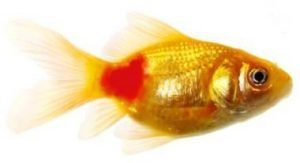
(Image Source)
Physical Signs
- Distinct bright red streaks on fins
- Patchy red discolorations on the flanks of the body
- Bulging eyes
- Bloated abdomens
- List Open sores
Behavioral Signs
- Hyperventilation (fast breathing)
- Gasping at the surface
- Erratic swimming
Potential Causes
Hemorrhagic Septicemia can be caused by various organisms or an Ammonia spike.
This is often triggered by poor water conditions with high amounts of decomposing organic debris. High levels of nitrate and a poor Redox tend to be common when Septicemia is present.
Possible Treatments
There’s no known cure for this disease. As the disease is internal, external treatments aren’t often effective, except in slight cases.
If that’s the case, treat your aquarium with a disinfectant and clean it.
To disinfect, try Acriflavine or Monacrin and use a 0.2% solution at the rate of 1ml per liter. Both will color your tank’s water but will disappear as they dissipate. If your fish don’t respond well, don’t proceed.
Your other option is to add an antibiotic to the food, good options are chloromycetin or tetracycline.
They tend to come in 250mg capsules, so if you’re mixing into 25 grams of flake food one should be enough.
A good tip is to keep your fish hungry, as they’ll be more likely to eat the mixture before it can dissipate.
Columnaris (Mouth Fungus)
Frequently mistaken for a fungal infection (Cotton Fin) due to its mold-like lesions, this is a common bacterial infection in aquarium fish.
It’s highly contagious and the outcome is often fatal.
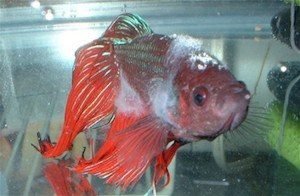
(Image Source)
Physical Signs
- Frayed and ragged fins
- Ulcerations on the skin
- Epidermal loss
- White or cloudy, fungus-like patches. Particularly on the gill filaments
- Mucus on the gills, head, and dorsal regions
- Gills will change color. Becoming light or dark brown
Behavioral Signs
- Breathing rapidly and laboriously
- Loss of appetite
Potential Causes
Columnaris is common where high bioloads or stressful conditions exist. These can be due to overcrowding, injury, inadequate diet, poor water quality, and unstable pH.
The bacteria can stay active in your tank for up to 32 days if the hardness is 50 ppm or more.
Possible Treatments
The disease does not survive in salt solutions of 1% or higher. So salt can be a great initial treatment if the case is less severe.
The use of a separate treatment bath can be great for infected fish, but, in severe cases, treatment of your entire tank is a must.
Another option would be to buy an antibiotic that treats gram-negative bacterial infections. Oxytetracycline is regarded as a very effective option.
To prevent the spread, remove any dead fish ASAP. This will stop surviving fish from picking at the infected fish, which can result in internal infection.
Fish Tuberculosis (Fish TB)
Not to be confused with the human disease, it’s common in tropical fish tanks.
It’s possible that it could go unnoticed, as the disease is not highly contagious and has no sudden dramatic effects.
Like the human version, it may not show signs until years after infection begins.
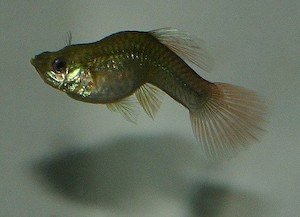
(Image Source)
Physical Signs
- Your fish may become lethargic
- Hollowed belly
- Turn pale
- Skin ulcers
- Frayed fins
- Fin and scale loss
- Yellowish or darker nodules may appear on the eyes or body
Behavioral Signs
- Loss of appetite
- Refusing to eat
- List Item #3
- Hiding behavior
Potential Causes
Fish TB is caused by one of the several species of Mycobacteria:
- fortuitum, M. flavescens, M. chelonae, M. gordonae, M. terrae, M. triviale, M. diernhoferi, M. celatum, M. kansasii, M. intracellulare, and M. marinum.
And the main cause for this disease is a poorly maintained aquarium. Mycobacterium thrives in low pH values, low oxygen, high soluble zinc, fulvic and humic acids.
All the problems you’ll encounter if you’ve overstocked or can’t be arsed to maintain your tank.
Possible Treatments
There is no current vaccine or satisfactory treatment available.
Once a population of fish is infected, the most likely scenario is euthanasia, followed by disinfecting your tank. It makes little sense to attempt to maintain a population with the illness.
They’ll have chronic health problems, poor growth, and feed conversion rates. Infected fish will be a constant source of infection.
Dropsy
Actually a symptom of an infection caused by bacteria present in all aquariums. There’s a buildup of fluid inside of your fish which damages its internal organs.
The mortality rate is high, even with fast treatment. Only if the diagnosis is made in the early stages is your fish likely to respond to treatment.
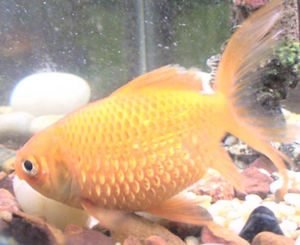
(Image Source)
Physical Signs
- Bloated appearance
- Scales stick out like a pinecone
- Extruding eyes
Behavioral Signs
- Lethargic
- Loss of appetite
- Rapid gill breathing
Potential Causes
In most cases, Dropsy is the caused by the bacteria Aeromonas. Now, this bacteria is commonly found in most fish tanks, however, it’s likely to infect fish that are stressed due to overcrowding or poor water conditions.
It can also affect fish with poor kidney function, which results in the absorption of water into the body cavity – causing the stomach to swell.
Possible Treatments
Unfortunately, Dropsy is usually untreatable and your fish will not survive. However, if you catch it early enough you can attempt to treat the condition.
It’s best to isolate the fish in its own treatment tank. You can then add a small amount of Epsom salt.
No more than 1/8 teaspoons per 5 gallons of water. Epsom salts consist of magnesium sulfate, unlike sodium chloride, which is found in regular aquarium salt.
Epsom salt will help to draw out some of the excess water from the fish’s body cavity and tissues.
You should also feed the affected fish with antibacterial food if it’s still eating. Adding Maracyn Two to the tank can also help, as it treats gram negative bacterial infections like Aeromonas.
Recommended Product: Epsom Salt
Use Epsom salt to help treat diseases like Dropsy and Popeye.
Bacterial Fin Rot
Fin Rot starts at the edge of your fish’s fins, destroying more and more tissue until it reaches the base.
At this point, your fish will never be able to regenerate the lost tissue, and the disease may start to attack its body.
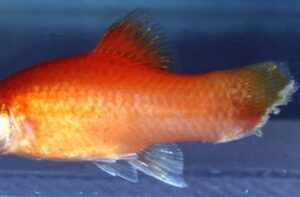
(Image Source)
Physical Signs
- Milky white areas appearing in the fish’s fins or tail, particularly around the edges
- Shredded-looking and tattered fins decreasing in length
- Exposed fin rays
Behavioral Signs
- Increasing difficulty swimming
Potential Causes
Fin Rot is often caused by several bacterial diseases such as Flavobacterium Columnare, Aeromonas, and Pseudomonas.
However, although it’s caused by these types of bacteria, the root cause of Fin Rot is always due to the fish’s environment.
A poorly maintained tank or exposure to stress is a contributing factor. When fish are moved, housed in an overcrowded tank, or with aggressive fish that chase and nip at their fins, they’re more vulnerable to Fin Rot.
Possible Treatments
There are three ways you can go about treating Fin Rot: environmental, antibacterial, and antibiotics.
Fixing your aquarium’s environment is fundamental and will prevent further issues. Perform a couple of large 20-50% water changes with clean, aged water, and attempt to remove as much debris and detritus as you can.
You should check and clean all your filters, give the gravel a good clean, especially if you’re using an undergravel filter. Test for Ammonia, Nitrites, and Nitrates.
Look out for any tank bullies that could be nipping or fighting with other fish. You may have to remove them. If your tank is overcrowded, you’ll need to rehome some of them.
For antibacterial treatments, most commercially available medicines can be effective. Melafix is a good example. If you can, separate the infected fish and always follow the instructions.
If you catch Fin Rot early enough, you shouldn’t need to use antibiotics. But, if you do, you’ll want one that’s effective against gram-negative organisms.
Popeye
Also known as exophthalmia, it’s caused by a hemorrhage produced by gas in the capillaries of the eye socket, affecting one or both eyes.
Your fish’s eye(s) will start to protrude from its head, and if left long enough without treatment, can fall out.
Not often fatal, however, if you don’t treat Popeye, it could spread and cause death.
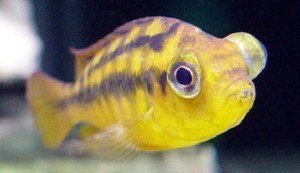
(Image Source)
Physical Signs
- One or both eyes protruding
- Cloudy eye
- Bloodstained eye
- Ruptured eye
Behavioral Signs
- Loss of vision
- General signs of lethargy
Potential Causes
There are two types of Popeye: Unilateral and Bilateral. The root cause of a bilateral infection tends to be due to chronically poor water conditions for extended periods of time.
It’s generally found in aquariums that aren’t taken care of properly or have not fully established the nitrogen cycle.
While Unilateral Popeye may be caused by physical damage to the fish. This can include rough handling, collisions or fights between fish, and scraping the eye against hard objects.
Possible Treatments
Popeye can be difficult to treat because it consists of three different problems: damage to the cornea, accumulation of fluid behind the eye, and bacterial infection.
Assuming the fish is subjected to optimal water conditions and a balanced, vitamin-rich diet, minor corneal damage can improve over time.
And if your fish is healthy (in other regards), the swelling can diminish with time.
Epsom salt can be used to reduce swelling and should be used at a dose of 1-3 teaspoons per 5 gallons. It can be used to treat both salt and freshwater fish, however, it’s best to do so in a separate hospital tank.
Antibiotics and antibacterials similar to those used to treat fin rot can be useful for preventing damage to the cornea turning into full-blown Popeye.
However, once Popeye develops, different medications will be needed.
Look for antibiotics used to fight against internal and systemic infections. And it’s best to administer them in food rather than adding to the water.
Cloudy Eye
Your fish’s eye will come cloudy/hazy to the point of whiteness and can lose its vision.
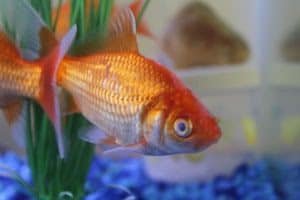
(Image Source)
Physical Signs
- Cloudy white or gray “haze” over the eye(s)
Behavioral Signs
- A loss of vision
- May show signs of distress
Potential Causes
These can vary, it could be due to an increase in parasites, severe stress, old age, or malnutrition.
But, the most common case of Cloudy Eye in aquarium fish tend to be as a result of poor water quality. Especially when the pH drops too low.
Possible Treatments
You’ll need to investigate the quality of water in your tank. Test the pH level of your aquarium, if it’s below 6.8, and especially if it’s lower than 6.4, perform more water changes.
Once the water quality higher, fish tend to recover by themselves. If that doesn’t work, treating the fish with Melafix is recommended.
Swim Bladder Disease
Rather than a single disease, the name refers to issues which affect your fish’s swim bladder. It can strike the majority of species (most common in Goldfish and Betta).
Your fish’s swim bladder won’t function normally due to bacterial or parasitic infection, physical damage, or birth defect.
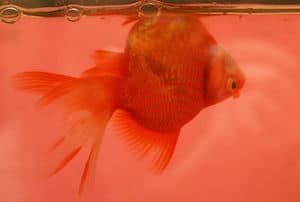
(Image Source)
Physical Signs
- Swollen belly
- Curved spine
Behavioral Signs
- Fish sinks to the bottom and struggles to rise up
- Fish floats to the top upside down
- Fish swims with its tail higher than its head (this is normal for headstanders)
Potential Causes
Swim Bladder disease can be caused by compression of the swim bladder, bacterial or parasitic infection, physical damage, and birth defect.
Compression of the swim bladder can happen as a result of rapid eating, overeating, or gulping air. Eating freeze-dried or dry flake food which expands when it becomes wet can sometimes lead to an enlarged stomach.
Parasites or bacterial infections can inflame the fish’s swim bladder causing the disorder. Physical damage from a fight, hard blow, or fall can damage the swim bladder on occasion.
In some cases, the swim bladder has become deformed as a result of breeding.
Blood parrot cichlids and fancy goldfish are common examples. While they may swim properly when healthy, constipation and physical injuries can affect them more severely than normal fish.
Possible Treatments
Due to the different causes of Swim Bladder, there’s not one single medication that can be recommended.
Bacterial/parasitic one way, physical another. However, exposing the fish to warmer waters can help.
You should transfer the fish to a hospital tank filled with water from the main aquarium.
The heater can be set up to 9 degrees F above the main tanks temperature (take care doing this, some species are sensitive to warm water and lower oxygen levels).
Don’t feed the fish for 3 days, on the fourth day, feed the fish cooked and skinned peas. You can achieve the best consistency by microwaving or boiling them for a few seconds. This can often resolve many cases of Swim Bladder Disease.
Lowering the waterline can also help. However, you should always leave it a few inches above the height of the fish so you don’t risk exposing it to dry air.
If this doesn’t work, and the fish is having normal bowel movements, it could be the sign of an infection. Treatment with a broad-spectrum antibiotic may help.
Note: this disease is rarely curable.
Parasitic Fish Infections
Ich (Ick or White Spot Disease)
Ich is one of the most common and persistent parasitic diseases found in aquariums. It’s caused when a protozoan attacks and attaches itself to your fish’s body, fins, and gills.
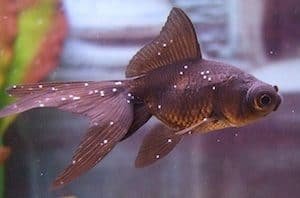
(Image Source)
Physical Signs
- White spots on the body and gills
- White spots may join together to form white patches
- Clamped fins
Behavioral Signs
- Labored breathing. Your fish may gasp for air at the surface or stay by the filter to try and get more oxygen.
- Loss of appetite
- Your fish may rub up against objects in the tank
Potential Causes
A major cause of this disease is sudden temperature drops. This can happen during colder winter months or if replacement water is at a lower temperature.
Outbreaks can also occur when you introduce that were incubating the disease into a poorly-maintained aquarium. As well as decorations or plants that are carrying cysts of the parasite.
Possible Treatments
Once the parasites establish themselves in your aquarium, it’s difficult to control because of the rate they reproduce. If you don’t control it, there’s a 100% mortality rate. So it’s important you act fast.
Because the disease is so common, you can easily pick up medication from your local aquatic shop or online. Follow the instructions carefully and always remove carbon from your filter when medicating.
You should also use other treatments alongside medication. Turning up the water temperature to as high as 30°C/86°F (if your fish can tolerate it), as this will help speed up the life cycle of the parasite.
Combining aquarium salt (not table salt) to increased temperatures will further effectively kill off Ich. Salt can disrupt the fluid regulation of Ich and helps your fish’s natural mucous or slime coats to protect it from the parasite.
Velvet (Gold Dust Disease)
Also known as ‘Rust’, it’s a common disease in aquarium fish, and has the potential to kill every inhabitant in your tank.
Caused by a species called Oödinium, it’ll find and attach itself to your fish’s skin and gills. destroying the cells and feeding off of the nutrients inside.
Once it’s done feeding, it drops off – dividing into dozens of cells.
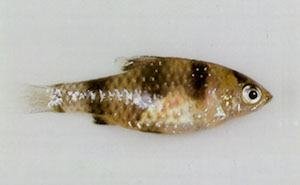
(Image Source)
Physical Signs
- Fine yellow or light brown film on skin
- In advanced stages, the skin will peel off
- Clamped fins
Behavioral Signs
- Scratching against hard objects
- Lethargic behavior
- Rapid and labored breathing
- Loss of appetite and weight loss
Potential Causes
Velvet disease is caused by one of several species of Oödinium and is common in poorly maintained aquariums.
Including abrupt changes in water temperature, not performing frequent water changes, adding new fish without quarantining, and the introduction of plants with cysts (new plants should be disinfected before they’re introduced).
Possible Treatments
It’s highly contagious and is usually in advanced stages before being diagnosed, so you should take action as soon as possible.
Common medications used include copper sulfate, methylene blue, formalin, malachite green, and acriflavin.
All of which can be found in common fish medications designed to combat this disease. Remember to always remove your activated carbon when medicating your tank.
Velvet parasites rely on photosynthesis for some of their energy, therefore dimming your aquariums lights or leaving your tank in total darkness can aid the treatment process.
Raising the water temperature can help speed the process. But, this tactic is not practical for all fish and may induce further stress – further weakening your fish’s immune system.
Hole-in-the-head (Head and Lateral Line Erosion)
Also known as Hexamitiasis, this parasitic disease can affect both fresh and saltwater fish. Lesions can appear on the head and flanks of the fish, hence the name: Hole-in-the-head.
This infection can also be responsible for head and lateral line erosion (HILLE) disease in fish.
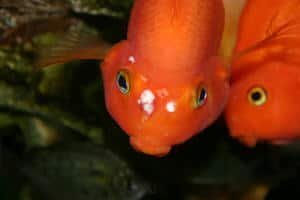
(Image Source)
Physical Signs
- Pale, eroding holes over the head
- Fish may look as if it is being eaten alive
- Coloration becomes subdued
Behavioral Signs
- Don’t often show until the condition is serious
- Can show general signs of lethargy
- May have trouble swimming due to a loss of balance
Pro Tip: Not all species of fish show the same symptoms, and do not always develop lesions to the same degree.
Potential Causes
Causes of this disease have been long debated, and nobody can say with certainty what the main trigger is.
However, the most accepted cause is the use of activated carbon in closed aquarium ecosystems.
Other factors can include nutritional deficiencies, especially key vitamins and dietary iodine.
Water quality can also play a role. Aquariums with high nitrate levels can cause fish to develop the illness.
Possible Treatments
If the infected fish has developed pale, eroding holes over its head, it’s in real trouble.
The open lesions provide an entry point for other pathogens which can cause further illnesses.
However, It’s possible for infected fish to improve when all activated carbon is removed and large percentage water changes are performed.
Improvements in nutrition have also been shown to benefit the fish.
Neon Tetra Disease
This can infect a wide variety of different Tetra species. It’s a set of bacterial infections caused by a parasite which enters the fish, invading the stomach and digestive tract – consuming the fish from the inside out.
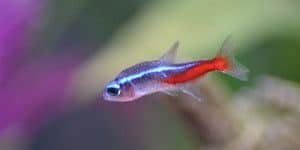
(Image Source)
Physical Signs
- Cysts on the body
- Loss of color in the red stripe and/or milky/brownish coloration
- Pale areas around the dorsal fun
- Weight loss
- Extreme cases can cause the fish’s spine to curve
- Advanced stages can end in secondary bacterial infections which cause bloating and Popeye
Behavioral Signs
- Difficulty swimming
- Erratic swimming
- Separating from the school
Potential Causes
Caused by a parasitic organism known as Pleistophora Hyphessobryconis, it feeds on the fish until it dies.
This is can occur when fish eat other dead fish or even from eating live food servings. The live food can act as a carrier, transmitting it to your fish once they eat it.
Possible Treatments
Unfortunately, there’s currently no medicine or treatment for infected fish. You should remove the infected fish and humanely euthanize them to stop further contamination.
Your best course of action would be to take safety measures against a second outbreak. You can do this by maintaining high-quality water levels and regular cleaning.
When buying new fish, be very strict when choosing, and always quarantine them for a couple weeks before introducing them.
Fungal Fish Infections
Body Fungus
Fungi are opportunistic, and given the chance, it will invade most organic material, including live tissue.
If you maintain healthy aquarium fish you shouldn’t have a problem, as the mucus layer on their skin will prevent the spores from infecting its living tissue.
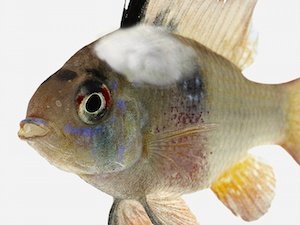
(Image Source)
Physical Signs
- Long, white fluffy strands growing from the body (can also grow on the head and fins)
- Debris can give them a brown, reddish or green colors
Behavioral Signs
- Not usually affected until later stages
Potential Causes
Body fungus tends to appear if your fish’s mucus layer is damaged and it’s living in unhealthy conditions. Rough handling, fin nipping, and fighting can all lead to damaged mucus.
Diseases which cause open wounds like Ich, ulcers and Hole-in-the-head disease can also lead to body fungus.
Environmental stress caused by chilling, poor water quality and incorrect water chemistry can weaken your fish’s immune system and lead to Fungus growth.
Possible Treatments
You’ll need to act fast, because it can spread rapidly on your fish, making it vulnerable to secondary infections. And Fungus itself will kill your fish if it’s not treated.
There’s a number of commercial medications available for treating Body Fungus. These tend to be based on organic dyes, like malachite green.
However, antifungal medications are not suitable for all species so isolate the fish in a hospital tank.
Cotton Fin Fungus
Also known as Cotton Wool Disease, it’s a condition that typically affects aquarium fish with weak immune systems.
Characterized by the cotton wool growths, it’s fairly common and it’s important to address this immediately before it can cause a lot of damage.
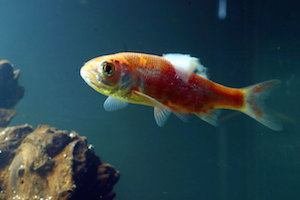
(Image Source)
Cotton Fin looks similar to Cotton Mouth disease, however, Cotton Mouth’s a serious bacterial infection called Mouth Fungus (Even though it’s not a fungus).
It can be difficult to tell the two apart, but generally, Cotton Mouth has a rougher, more granular appearance and can be a dull grey-white than true white fungus.
Physical Signs
- Cotton-like fluffy or wispy growth on the fins
Behavioral Signs
- No real behavioral signs. Fish tend to act fine until the fungus appears on the skin’s surface
Potential Causes
Poor water quality, decomposing material, and not maintaining your tank properly can lead to Cotton Fin.
However, even if you’re very good at maintaining your tank, old fish or ones suffering from an injury could contract the disease. Especially if your fish is bullied or fighting a lot.
Possible Treatments
You’ll be pleased to know that treatment is relatively easy, and can be done with fungal treatments.
The basic four used are salt, Methylene blue, Malachite green, and Acriflavine (although this is now getting withdrawn because it can be toxic to humans).
Malachite green is readily available and is known to be effective. You can also add aquarium salt to your tank at a low level of 1-3 grams per litre.
Viral Infections
Lymphocystis
This common viral infection affects fresh and saltwater fish’s skin and fins. Not serious, per say, as it rarely ends in death; it only disfigures fish.
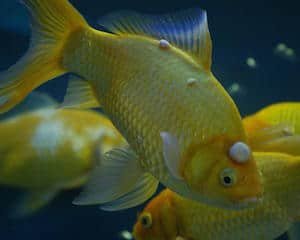
(Image Source)
Physical Signs
- Growths on the skin or fins (look similar to cauliflowers)
Behavioral Signs
- Do not normally behave differently from uninfected fish
- Large numbers of growths on the fins and gills could cause breathing and summing difficulties
Potential Causes
This virus can only infect your fish if it’s introduced to your aquarium by an infected fish and live food.
You can reduce the chances of an infection by quarantining new fish for a few weeks before adding them.
As well as avoid feeding your fish live food or only feeding with home cultivated live food.
Possible Treatments
You may be disheartened to know that there’s no good treatment currently available.
However, if you maintain the correct water quality, chemistry, nutrition, and population density, most cases of Lymphocystis will resolve itself: warm water fish may only take a few weeks. Coldwater or cool water fish up to 6 weeks.
If your fish has many growths covering important organs (e.g. gills), there may be a high chance of a secondary infection.
If this is the case, isolate and monitor for bacterial, parasitic, and fungal infections – treat with appropriate drugs.
True Worm Parasite Fish Diseases
Flukes (Skin and Gills)
Flukes isn’t the name of a single disease, rather the name of a number of parasites.
Commonly called Gill (Dactylogyrus spp.) or Skin Flukes (Gyrodactylus spp.), they’re common in freshwater tropical and marine fish. Unlike other health problems in fish, Flukes can infect a healthy fish.
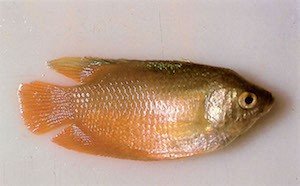
(Image Source)
They’ll attach and drill into the flesh of your fish, leaving holes which can result in secondary infection. If they attach to the gills, they’ll reduce your fish’s ability to take in oxygen.
If they reproduce, then your fish will become listless and die of either a bacteria infection or suffocation.
Physical Signs
- A layer of mucus covering the gills or body
- Gills look like they’ve been chewed
- Reddened skin
Behavioral Signs
- Scratching against objects
- Rapidly moving gills
Pro Tip: Pale fish with drooping fins, rapid respiration and/or hollow bellies indicate more extensive infestation. A true diagnosis can’t be certain without looking at biopsies or scrapings under a microscope.
Potential Causes
Bad environmental conditions such as poor water quality, overcrowding, high ammonia, and stress create conditions that can lead to outbreaks.
Flukes are commonly present in aquariums, however, they’ll remain harmless under favorable conditions.
Avoiding stress is key.
Possible Treatments
You can treat your fish with Praziquantel. This is an anti-worm medication which prevents Flukes and treats infections caused by them.
A huge advantage of is medicine is that it’s harmless to all species, not toxic to plants, and has no negative impact on aquarium filters.
Recommended Product: Fish Tapes Praziquantel
Praziquantel is a proven method to treating Flukes and any infections caused by Flukes.
Nematodes (Roundworms)
These threadworms can infect all types of fish and can affect all organs and cause severe damage to your fish.
They can be hard to treat, therefore it’s vital to prevent introducing them into your aquarium.
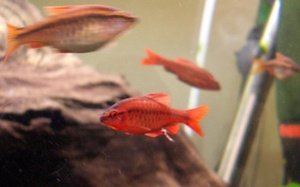
(Image Source)
Physical Signs
- Worms hanging out of the anus
- Severe cases can cause the belly to sink in
Behavioral Signs
- Loss of appetite
- Lethargy
Potential Causes
They have to be introduced into your aquarium. Adding something organic like wood, fish, and raw fish food can infect your tank.
Leaving uneaten food in the water can increase the chances of an outbreak.
However, Nematodes can be present in your tank and not cause problems, unless your fish becomes weakened.
Possible Treatments
You could try treating your fish using Parachlorometaxylenol. You can mix it in their food or as a bath, in which case you should use 10 ml per liter.
Another treatment could be to feed them medicated fish food containing Thiabendazole. However, this can be hard to find and difficult to get the fish to eat.
To prevent further outbreaks, try reducing the amount of food you feed your fish and siphon up uneaten food. Adding Gourami or Pleco fish will help clear your substrate of uneaten food.
External Arthropod Parasite Fish Diseases
Anchor Worm
This parasite is extremely rare in aquarium fish, and despite its name, it’s not a worm. It’s a copepod, and it’s easy to spot.
Named “anchor,” because they’ll get deep into your fish’s body (commonly in the tail or dorsal fin). This damage weakens your fish – opening it up for new diseases or secondary bacterial infections.
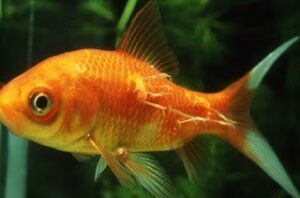
(Image Source)
Physical Signs
- Redness around the anchor point
- Ulcers can appear
- Inflammation on its body
- Tiny white-green or red worms found at the base of fins
Behavioral Signs
- Difficulties breathing
- General lethargy
- Rubbing (flashing) against objects
Potential Causes
It’s caused by adding fish into your aquarium which is already carrying the parasite or plants that have larvae on them.
Possible Treatments
Potassium permanganate is considered the best treatment, and it can be used as a tank treatment or dip.
Other options include formalin dip, salt dip, and modern antiparasitics.
Removing the parasite with tweezers is one of the surest ways to get rid of it. You’ll need to take care when doing this.
Make sure you don’t break the tail off; leaving the head inside. Dip the fish back into the water every few seconds so it can breathe.
If the parasite has burrowed deep into your fish this may not be a good idea. Pulling it out could cause more trauma than leaving it in and treating it.
Argulus (Fish Lice or Fish Louse)
One of the biggest parasites, ranging from 5 to 10 mm in length, they’re easy to spot if you know what you’re looking for.
You tend to find them located behind the find or around the head, in sheltered locations.

(Image Source)
They’ll attach and feed off of your fish using their spines, suckers, and hooks – causing it intense irritation.
Your fish will become damaged and stressed through constant piercing of its skin. Bringing the danger of opportunistic bacteria and secondary parasitic infestations.
Physical Signs
- They’ll appear as small dark spots on your fish
- Red markings, ulcers, or inflamed areas where the lice have been
Behavioral Signs
- Aggravated and restless
- Usually fish will rub against aquarium glass or other objects in an effort to remove lice
Potential Causes
Usually occurs when a fish from an outdoor pond is transferred into an indoor aquarium. Lice will travel from fish to fish, spreading bacteria and viruses. You’ll want to get rid of them fast.
Possible Treatments
Holding the fish in a damp cloth and using tweezers to remove the parasite and cleaning the wound with an antiseptic is a common method.
If you don’t want to do this, you can use specialized medications.
If you’re manually removing them, it’s recommended to treat the whole tank with medication to kill any free swimming parasites.
Organophosphates tend to be an effective cure.
Prevention is the Best Form of Medicine
The ordeal of dealing with diseased fish isn’t fun for anyone. So the best way to ensure your tanks inhabitants live a long happy life is to create a healthy stress-free environment for them.
Nutritious Diet
A proper diet will do an excellent job of providing your fish with the range of nutrients it needs to stay healthy.
No Dramatic Temperature Changes
Maintain suitable water temperatures with no sudden changes.
Fast changes in water temperature can be extremely stressful for your fish and compromise their immune system. We recommend investing in a quality heater and thermometer.
High Water Quality
Water quality is vital to keeping happy and healthy fish.
Investing in an efficient filter is key for removing debris and promoting healthy bacteria in your tank. Perform frequent water changes and use test kits to make sure ammonia and nitrate levels are safe.
Observing Your Tank
Monitor your tank regularly to ensure everything’s okay. Equipment malfunctions or deceased fish can quickly create a toxic environment for your fish.
It’s vital you catch and fix these problems ASAP.
Quarantine New Fish
When you purchase a new fish, make sure they’re free of all signs of stress and disease. Be picky and take your time making sure that they’re healthy.
And always quarantine a new fish for a few weeks to ensure it’s not going to contaminate your tank.
SOURCE-https://modestfish.com/fish-disease-guide/


